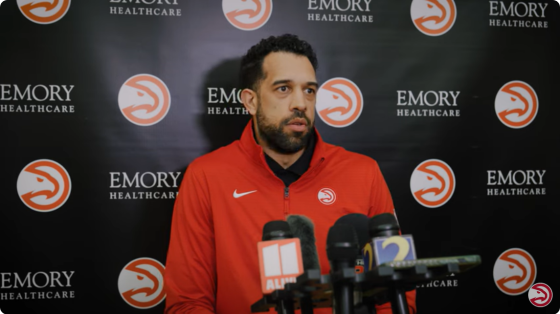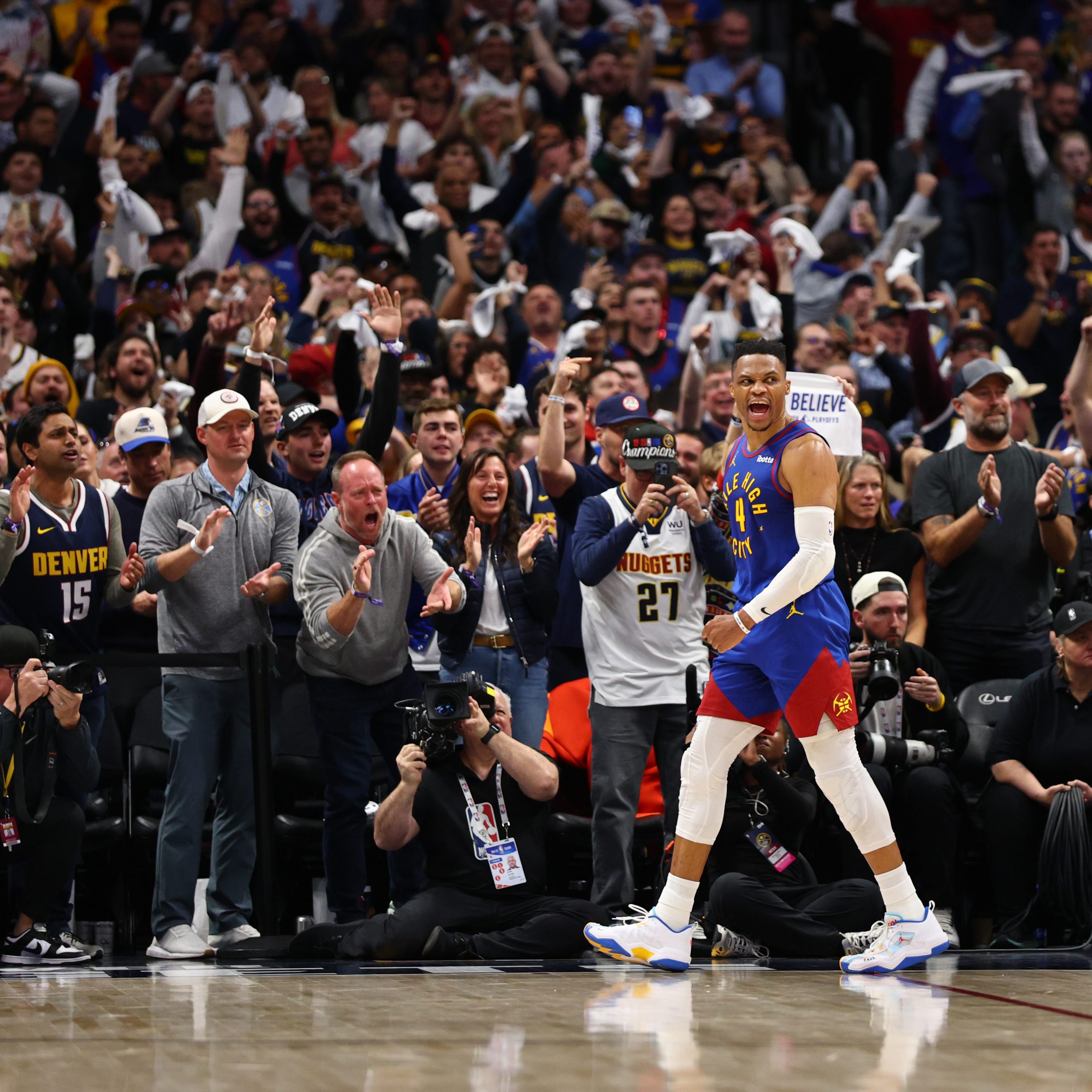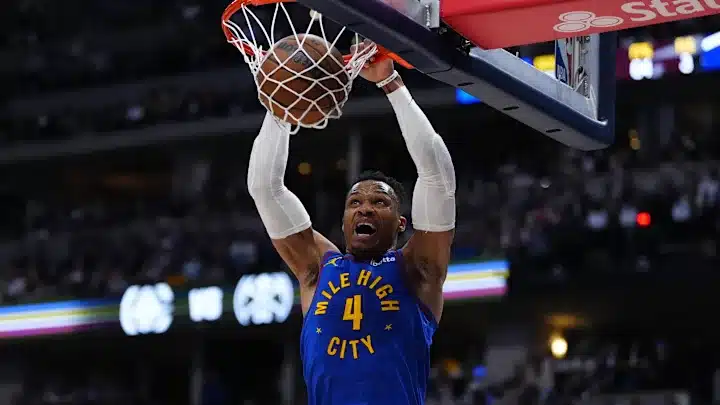Key Highlights:
-
- Sharpe is averaging twice as many points this season as last year (19.8 vs. 9.9)
- Despite his rate of assisted makes dropping from 67 to 53 percent, his true shooting percentage is slightly better (57.2 vs. 56.8)
- His assist rate has jumped from 7.5 to 12.3 percent
Shaedon Sharpe finds himself in an eerily similar position to how he ended his rookie season: Running the offense on a team missing all of its lead creators. Last year, as injuries mounted and the losses piled up, Sharpe assumed significant ball-handling duties in the absence of Damian Lillard and Anfernee Simons. Over his final 10 games, he averaged 23.7 points (57.4 percent true shooting), 6.1 rebounds and 4.1 assists during a 2-8 stretch for the Portland Trail Blazers that featured them on the wrong side of quite a few emphatic blowouts.
That wasn’t the plan entering 2023-24; Sharpe didn’t even open the year as a starter and his off-ball prowess was supposed to complement the likes of Simons and No. 3 overall pick Scoot Henderson. Yet only nine games in, the Blazers are down Simons, Henderson and Malcolm Brogdon. Although Sharpe’s development is certainly among the foremost priorities, how it’s unfolding probably looks different than initially envisioned.
Nonetheless, the 20-year-old Canadian is handling these dynamics aptly. Skylar Mays typically runs the show these days, but Sharpe is the focal point of the offense. His duality of usage, routinely operating on and off the ball, is a testament to his versatility more than anything about his hierarchy within the offense.
How Has Sharpe Improved?
Since entering the starting lineup eight games ago following Simons’ injury, he’s averaging 20.5 points (58.1 percent true shooting), 4.9 rebounds and 3.0 assists. Include that first game as a reserve and the scoring ticks down slightly to 19.8 points on 57.2 percent true shooting.
From the outset of his rookie year, he impressed with pogo-stick bounce, a picturesque jumper and a keen sense of when and how to attack space off the ball. He utilizes off-ball screens soundly, is quite potent as a cutter, and is drilling 42.1 percent of his catch-and-shoot triples in 2023-24. All of those traits remain. The difference is they’re beginning to apply to Sharpe’s on-ball repertoire.
At 6’6″ with exceptional fluidity and explosiveness, he’s burgeoning as a driver. His frame and vertical pop enable him to overwhelm defenders of all sizes. He’s fearless challenging rim protectors. After averaging 4.4 drives per 36 minutes as a rookie, he’s up to 8.0 per 36 minutes. The way Sharpe senses space and powerfully glides through the air instantly popped as an off-ball scoring asset a year ago. Now, it’s behooving him as a creator.
Not every endeavor has been fortuitous. His intrepid demeanor inspires some rather ambitious finishing attempts. According to Cleaning the Glass, he’s shooting 52 percent around the hoop (22-of-42, 15th percentile among wings) — a sharp decline from 67 percent (69th percentile) last year.
The upshot of his approach is a massive spike in free-throw rate (.307 vs. .162). He’s been a bit unlucky with a handful of good looks rolling out, so I expect this aggression to be a long-term benefit between more free throws and a plausible regression to the mean at the rim.
Converting unassisted makes is a whole different world than converting assisted makes, even at the basket. Sharpe is learning that disparity. His strength, explosion and body control are too good for him to hover around 50 percent forever. As he further assimilates reps, he should add counters, better navigate swarming limbs and re-establish himself as a high-level finisher.
While he’s experienced a downturn around the rim, he’s simultaneously experiencing an upswing as an off-the-bounce shooter. Scoring-wise, that was one of his biggest shortcomings last season. On 232 pull-ups, he posted an effective field goal percentage of 39.2, which ranked 92nd among 95 players with at least 200 attempts. This year, he’s at 54.7 percent on 53 attempts, good for fourth among 38 players with 50 or more attempts.
Previously, many of his ball-handling reps felt like he was winging it. That no longer feels the case. His manipulation and routes around screens are improving. He’s more assured about when he intends to drive and when he’ll shimmy into a jumper. He’s reading defenses, digesting the information and then making decisions.
Fifty-three attempts are not enough for any firm declarations, of course. He could come spiraling back down. But he is playing a savvier, calmer, more well-rounded brand of basketball when he’s running the show and hunting pull-ups.
Both of these storylines — the driving and shooting — coalesce to showcase a wing who’s better equipped engineering offense for himself. The dichotomy between his on- and off-ball scoring was stark in 2022-23. According to PBPStats, he generated an effective field goal percentage of 63.8 on assisted buckets, compared to 44.8 percent on self-created ones.
That gulf has substantially narrowed. This season, his effective field goal percentage on assisted shots is 59, compared to 52.1 percent on self-created ones — and it’s occurred despite a notable leap in creation responsibilities.
Sharpe’s blossoming as an initiator seems sustainable to some degree in part because of how he’s grown as a playmaker. He sees the floor like someone who’s gradually understanding the pressure his scoring threat inflicts on defenses. Sometimes, his ideas are ahead of his skill level. He’ll throw sloppy pocket passes, rush a swing pass or force a read that he’s not yet capable of delivering. Other times, his score-first ethos leads him into trouble and he misses opportunities altogether.
Even so, this is a second-year wing with dynamite scoring potential who’s increasingly working in tandem with his rolling bigs to maximize all he and they can achieve. The progression is evident and encouraging, and his assist rate has swelled from 7.5 to 12.3 percent.
Where Does He Need To Keep Improving?
The beauty of how far Sharpe’s come in so little time is how much room still exists ahead. As teams continually study his on-ball patterns, they’ll probably recognize his issues with and aversion to going left. The Sacramento Kings picked up on it in the second half last week and it really limited what he could do. The Los Angeles Lakers noticed it as well on Sunday.
Both as a dribbler and scorer, he’s uncomfortable using his left. It hamstrings his pacing, explosion and finishing angles. Once you spot it and the aggression with which some opponents emphasize sending him that way, it’s impossible to miss. He’ll need to rectify that in the ensuing months and years. Otherwise, it’ll sit atop scouting reports and become quite the hindrance to his on-ball exploits.
Discovering a gear between first and third would do wonders for his efficiency and decision-making as a driver. He holds a tendency to see an opening and eagerly attack it — blowing past the point of no return — only to have that opening evaporate without a backup plan.
His explosiveness translates from a standstill. A lengthy runway to rev up isn’t always necessary. Learning to decelerate and adapt will serve him well. There’s been a handful of plays in which dialing down the speedometer would spark a better chance for himself or others.
A dunk is constantly possible for him. Altering the thought process takes time. He’ll figure it out through sustained reps and film study. Right now, though, it’s one of his shakiest habits and negates some of the value of his advantage creation.
With Simons, Henderson and Robert Williams III all sidelined, the injury bug threatened to derail the developmental playground this rebuild presents for the Blazers. Instead, Sharpe’s using this time to rock out on the ball, display his improvements and highlight future areas for growth.
There is much left to accomplish before hopes of stardom are actualized. But the checklist is shorter than when the season kicked off three weeks ago. And that is a bright reason for optimism in Portland amid a tumultuous first few weeks.






